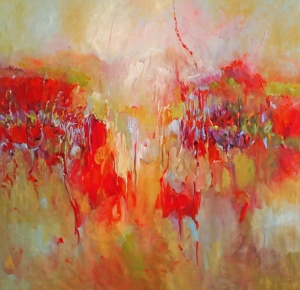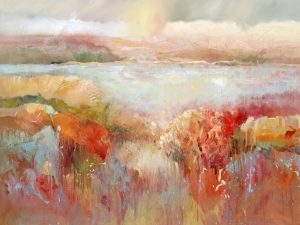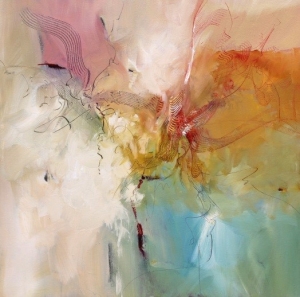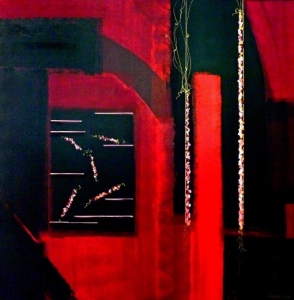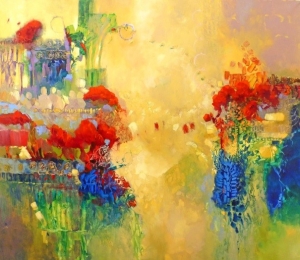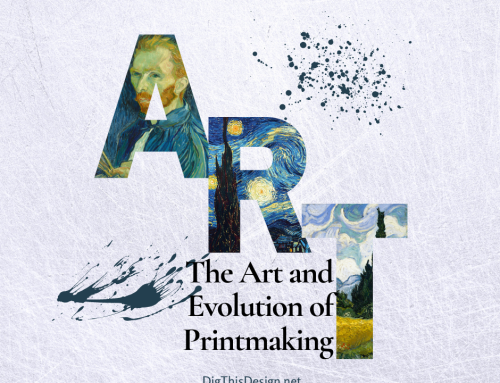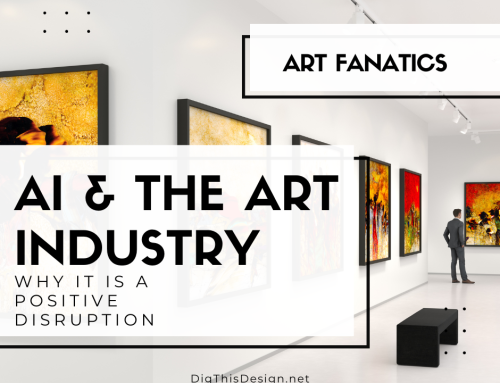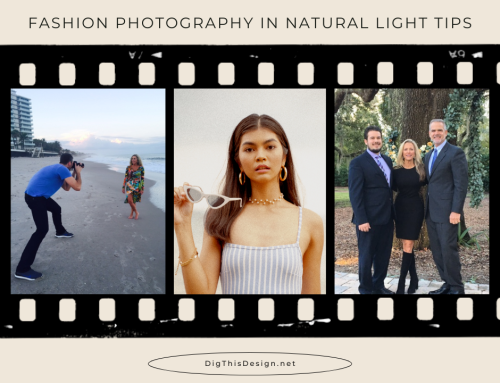We have a very special interview with Barbara Krupp, an extremely talented artist. She was gracious enough to give us an interview and provide some of her life stories and inspirations. We hope you enjoy her as much as we have!
Introduction: My journey as a painter over the past decade has gathered momentum in ways I never anticipated. Professional recognition – which I have never sought – in the form of increased solo, group and now Museum shows has given me encouragement. And I believe my expressive potential has begun to mature.
My work today is expressionistically abstract but with a core of representational underlay. It may not be clear even to me, but there’s something in there. I work in acrylic, oil stick and pastels, and also in collage, using primarily paper and fabric.
I paint in two distinct regions of the United States. Summers are spent in the unsparing light of my country’s heartland, in Ohio. Its rhythms are essentially stretched and flattened: massive farms on vast plains. These have made themselves felt in my abstract nature paintings. And yet it is impossible to ignore the rugged, sometimes shattered, verticals of its urban landscapes as well. These are most clearly seen in my Canton Museum of Art show from 2013, called “Restoration, Recycling, Remembering.”
Winters pass on the shores of Southern Florida, a place of altogether softer, more flowing sensibility. The night in all its aspects – from the neon palaces of Miami Beach to the dark mysteries of the swamps – is important here, as are the early mornings. These odd juxtapositions and geographic shifts have much to do with the forms my pictures have taken.
Nature has always been my most fundamental inspiration. Gardens of many kinds, simple and complex, are behind the organizing principles of my work. But in recent years, nature as a larger force has begun to influence my paintings more directly.
1. Is there any piece of your work that really stands out to you as a piece that changed your style
Yes, “Free Spirit” I had been painting abstract nature and was looking for a different venue when I saw a pair of my shorts in the closet. I grabbed them and literally ran to my canvas. I started clipping, gluing, ripping, and painting. This was a beginning of a series titled “Trunk Show” Each piece is a fun look at the past, present, and future, of clothing. I started going to a clothing store for young people called “Ragstock” I bought many items to use in painting this series. Going back to the store accelerated my creative genes. I feel I will never have the time to put down and record every image that flies through my mind.
2. What were your motivations for working with abstract and acrylic art?
Actually, I started painting in oil when I was nineteen years old, but soon learned it did not dry fast enough for my fast paced world. I decided to try watercolor and I used it for 20 years. It was fast but it was not natural to my personality. So then I tried acrylic. Now I had substance, movability and quick drying. But of course I had to keep experimenting, so I added oil stick, pen and ink, and then along came the fabric and found objects.
3. Why did you change from gardens and nature as your inspiration to abstrac
I changed from traditional garden paintings to abstract after my trip to Ireland in the spring of 2004. I had been painting traditionally for 29 years. From one of my journals during that year I wrote “I regret I have not put down the evolution of my new work. I call it “abstract landscape.” It started very earthy, with orange, red, yellows, etc. They were scenes from Ireland. I call it, Ireland without the green. I have never gone back to traditional. I can say what I want simply by bypassing the complexity of unnecessary lines.”
4. It seems like travel has largely influenced some of your work and as it is constantly evolving can you explain how that has impacted some of your recent work?
Travel changes one’s self more than anything else in the world. It is a challenge if you travel as I do. I do a little planning and then allow room for error along the way, with the possibilities of getting lost. That is when the magic happens. Pre-conceptual ideas are gone with the wind.
What is in front of you is new. Then when painting time begins, a new myriad of visions and colors appear. The excitement of corralling them and then letting them explode on white canvas can be unfathomable.
5.What do you think most people connect to in your work?
Most people connect with my colors and translate them into places and esoteric moments .
This seems to be a contradiction here somehow vibrancy interlaced across space does bring peace if there is peace on both sides, in the artist and in the viewer. I have a few examples of what I call “Little Thoughts” that bring the five senses across in my art.
“Little Thoughts”
Wake up each day and look at a tree and know you are not alone…..
Without the babbling brook there would not be an ocean…..
Hear the birds and sing…..
Wait for the flower to open and then rejoice….
Want not, eat the fruits of the season….
Bright light, let it guide your day….
A note of music, the beat of the heart….
Color makes a rainbow….
6. Can you tell a little about your work with fabric and what inspired you to explore that?
I believe I answered this in the first question. I have been painting for 40 plus years and I have finished many series of artwork. I would like to take time to tell you about a few of them. The series “Hidden Cities” is a small series done primarily in black. Simply executed but in blackness there is spatial complexities. The boxes leave the mind delving into unsolved mysteries and each can add or subtract thoughts to enrich advancement. Reflect on the time of absolute silence and hear what it has to tell you. That is true beauty.
“Peppermint Candy” was accepted in a juried group show at the Toledo Museum of Art, Toledo, Ohio “Peppermint Candy” is a part of our attention span therapy. Concentrate on the moving parts of the right side of the brain (left side of painting) to the rigidity of the left side of the brain. (right side of the painting)
Another series I have completed is titled “Ephemeral World”
“the series “Ephemeral World” was inspired by reading “Invisible Cities” by Italo Calvino. It is a dialogue between Marco Polo and Kublai Klan. Each description of the cities is unique and each one presents a visual painting in my mind. The painting “City of Desires” was executed after reading…
“When a man rides a long time through wild regions he feels the desire for a city. Finally he comes to Isidora, a city where the buildings have spiral stair-cases encrusted with spiral seashells, where perfect telescopes and violins are made, where the foreigner hesitating between two women always encounters a third, where cockfights degenerate into bloody brawls among the bettors. He was thinking of all these things when he desired a city. Isidora, therefore, is the city of his dreams: with one difference. The dreamed-of city contained him as a young man; he arrives at Isidora in his old age. In the square there is the wall where the old men sit and watch the young go by; he is seated in a row with them. Desires are memories.” Italo Calvino
“Restoration, Recycling and Remembering” is a series that was shown at my one person show at the Canton Museum of Art, Canton, Ohio 2013
I thought of the state of the world, the excess in which we live: old structures are abandoned or torn down; new ones are put up unnecessarily. What would happen if we could take the lumber, steel, metals, etc. and make beauty out of the old steel mills, out of the hurricane damaged structures and even out of the hidden places in our minds. Could we rearrange them?
As a conclusion I would like to enclose a quote from my museum show:
“It is a pleasure to recognize the ever growing creativity in Barbara Krupp’s paintings. Her earliest paintings were of fluid natural scenes. With each passing decade, her work has grown to amazing depth. The pieces in this collection are characterized by magnificent spatial formulations and excel in rectilinear forms and bold color. In another direction are soft colored floating abstracts that have a magnificent design sense in their spatial freedom…. very sophisticated, yet warm and pleasing designs.”
Roger Coast
Professor Emeritus
Former Chairman of the Industrial Design Department
Cleveland Institute of Art
All images courtesy of Barbara Krupp

